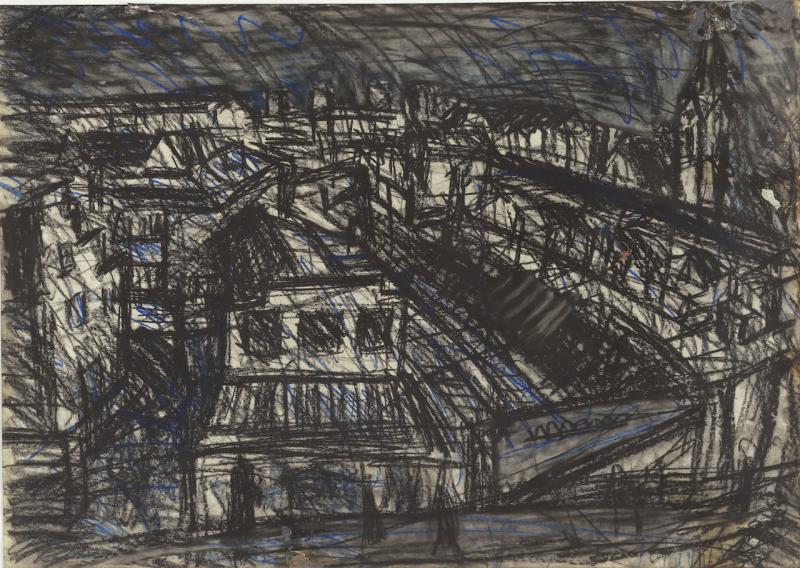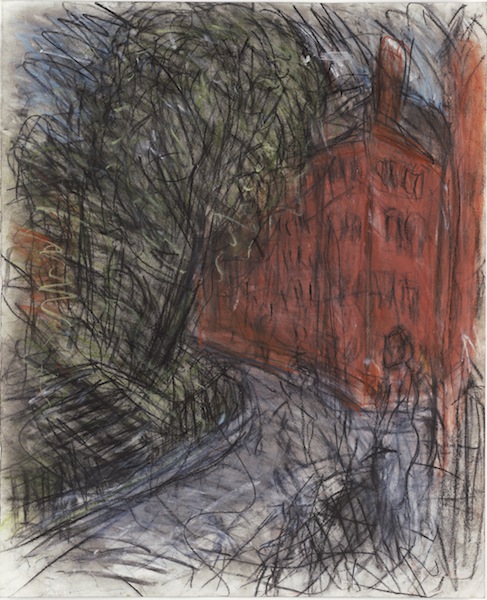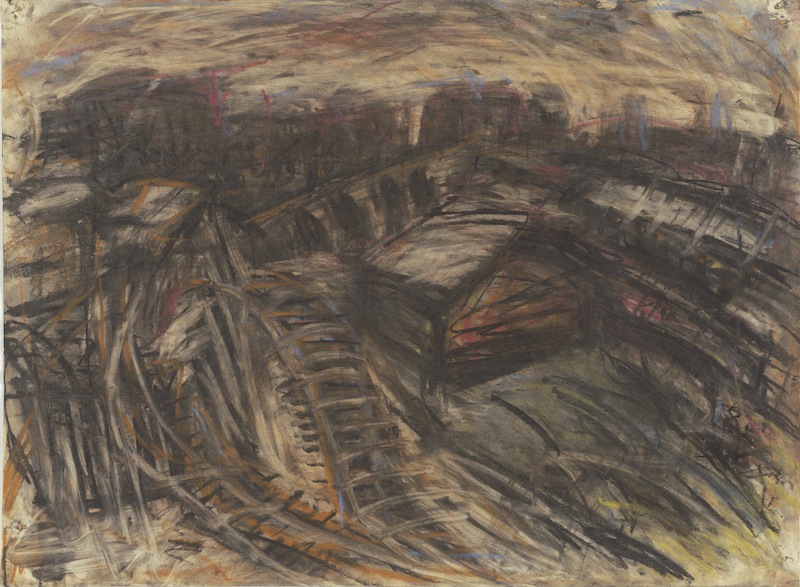Leon Kossoff: London Landscapes, Annely Juda Fine Art | reviews, news & interviews
Leon Kossoff: London Landscapes, Annely Juda Fine Art
Leon Kossoff: London Landscapes, Annely Juda Fine Art
A deeply affecting survey of an artist who captures a sense of London as a living, breathing organism

Sixty years of hard work, encapsulated in 90 drawings and a handful of thickly encrusted paintings, by the distinguished, obsessive, single-minded octagenerian artist Leon Kossoff (b 1926) vividly set out a passionate attachment to a simultaneously immutable and ever changing London. An East Ender, Kossoff has had several subjects: he has painted people, and has continually drawn after the Old Masters, first visiting the National Gallery as a schoolchild.
Working outside in all weathers, thick drawing paper attached to a large clipboard, Kossoff has looked at the resonances of his native city. People surging through underground stations, the old Hungerford Bridge looming over Embankment station, Kilburn underground, trains in the night, an ancient cherry tree carefully supported in its dotage, Hawksmoor’s Christ Church looming in its awesome grace, are some of his subjects, returned to again and again.
 He has made of London a surprisingly tangled web of lines deploying charcoal with varying amounts of pressure and a range of pastels, colours always subtle as though emerging through diffused light, our polluted skies making for absorbing visual effects. The sun never dominates. Those rare days when London has a New York sky of blazing blue holds no appeal for Kossoff.
He has made of London a surprisingly tangled web of lines deploying charcoal with varying amounts of pressure and a range of pastels, colours always subtle as though emerging through diffused light, our polluted skies making for absorbing visual effects. The sun never dominates. Those rare days when London has a New York sky of blazing blue holds no appeal for Kossoff.
This is old London, continuing to renew itself, reminding us that the postwar period has seen almost as much destruction and renewal as the Victorian, both building on the voids left by the blitz, and gasping for modernity in the strange new post-imperial world. The light is pearly, grey, softly blue, the winter sun gleaming, iridescent. Close up to any drawing, there is but a skein of lines. At a little distance shapes loom and a surprising number of people turn up, scurrying in the street, buying their train tickets or wheeling bicycles. (Pictured above right: Arnold Circus, 2008-10; charcoal and pastel on paper).
Kossoff’s London is always in a bit of disarray, functioning in a kind of workable controlled chaos. Like a living creature the city all is nervous tension. The presence of people is always evident, either actually there, as in the crowded children’s swimming pool, or suggested, for every image is centred on something manmade, from trains to city streets, buildings to bridges.
 He captures what is also peculiar to London – a sense of expectancy. Perhaps it is the continually variable weather and sky, so characteristic of this city. The artefacts of the city, from trainlines to building sites, seem almost as variable as the weather, and yet are also steadfast in their dignified appearance. What Kossoff gives us is not London as a shambles, but London as a resonant, living organism in which its buildings, in whatever state of being, act as both core and backdrop, skeleton and body, scenery and actor, in interchanges with the human inhabitants.
He captures what is also peculiar to London – a sense of expectancy. Perhaps it is the continually variable weather and sky, so characteristic of this city. The artefacts of the city, from trainlines to building sites, seem almost as variable as the weather, and yet are also steadfast in their dignified appearance. What Kossoff gives us is not London as a shambles, but London as a resonant, living organism in which its buildings, in whatever state of being, act as both core and backdrop, skeleton and body, scenery and actor, in interchanges with the human inhabitants.
It is an astonishing achievement, to make of London, and mostly of its more humble neighbourhoods, something so grand and so approachable. The unplanned confusion of Dalston Lane is treated with as much care as the architectural glory of Hawksmoor’s Christ Church. The artist himself, seeing the array of work before him, has confessed to being surprised and delighted by where he has been, and what he has seen (surprising for a man so personally reticent, who is rarely interviewed, and has in the past even disliked being written about). (Pictured above left: York Way, charcoal and pastel on paper).
His idiom harks back in certain ways to expressionism: the deep colours, a sense sometimes of violent change, and yet there is a sense of exquisite pleasure of the moment. The 10 or so paintings of the same subjects, deeply encrusted, thick paint in skeins of colour, brush and palette knife to the fore, are strikingly solid; the atmosphere is dense, and even when the scene is outdoors, there is a sense of enclosure, of being wrapped round by the scene. The drawings, though, almost dance and somehow communicate just that smoky smell of the air, the pause before rain.
This unmissable anthology of a major artist makes us see and feel the presence of London, anew and afresh.
Explore topics
Share this article
The future of Arts Journalism
You can stop theartsdesk.com closing!
We urgently need financing to survive. Our fundraising drive has thus far raised £33,000 but we need to reach £100,000 or we will be forced to close. Please contribute here: https://gofund.me/c3f6033d
And if you can forward this information to anyone who might assist, we’d be grateful.

Subscribe to theartsdesk.com
Thank you for continuing to read our work on theartsdesk.com. For unlimited access to every article in its entirety, including our archive of more than 15,000 pieces, we're asking for £5 per month or £40 per year. We feel it's a very good deal, and hope you do too.
To take a subscription now simply click here.
And if you're looking for that extra gift for a friend or family member, why not treat them to a theartsdesk.com gift subscription?
more Visual arts
 Help to give theartsdesk a future!
Support our GoFundMe appeal
Help to give theartsdesk a future!
Support our GoFundMe appeal
 Hamad Butt: Apprehensions, Whitechapel Gallery review - cool, calm and potentially lethal
The YBA who didn’t have time to become a household name
Hamad Butt: Apprehensions, Whitechapel Gallery review - cool, calm and potentially lethal
The YBA who didn’t have time to become a household name
 Bogancloch review - every frame a work of art
Living off grid might be the meaning of happiness
Bogancloch review - every frame a work of art
Living off grid might be the meaning of happiness
 Do Ho Suh: Walk the House, Tate Modern review - memories are made of this
Home sweet home preserved as exquisite replicas
Do Ho Suh: Walk the House, Tate Modern review - memories are made of this
Home sweet home preserved as exquisite replicas
 Ed Atkins, Tate Britain review - hiding behind computer generated doppelgängers
Emotions too raw to explore
Ed Atkins, Tate Britain review - hiding behind computer generated doppelgängers
Emotions too raw to explore
 Echoes: Stone Circles, Community and Heritage, Stonehenge Visitor Centre review - young photographers explore ancient resonances
The ancient monument opens its first exhibition of new photography
Echoes: Stone Circles, Community and Heritage, Stonehenge Visitor Centre review - young photographers explore ancient resonances
The ancient monument opens its first exhibition of new photography
 Hylozoic/Desires: Salt Cosmologies, Somerset House and The Hedge of Halomancy, Tate Britain review - the power of white powder
A strong message diluted by space and time
Hylozoic/Desires: Salt Cosmologies, Somerset House and The Hedge of Halomancy, Tate Britain review - the power of white powder
A strong message diluted by space and time
 Mickalene Thomas, All About Love, Hayward Gallery review - all that glitters
The shock of the glue: rhinestones to the ready
Mickalene Thomas, All About Love, Hayward Gallery review - all that glitters
The shock of the glue: rhinestones to the ready
 Interview: Polar photographer Sebastian Copeland talks about the dramatic changes in the Arctic
An ominous shift has come with dark patches appearing on the Greenland ice sheet
Interview: Polar photographer Sebastian Copeland talks about the dramatic changes in the Arctic
An ominous shift has come with dark patches appearing on the Greenland ice sheet
 Donald Rodney: Visceral Canker, Whitechapel Gallery review - absence made powerfully present
Illness as a drive to creativity
Donald Rodney: Visceral Canker, Whitechapel Gallery review - absence made powerfully present
Illness as a drive to creativity
 Noah Davis, Barbican review - the ordinary made strangely compelling
A voice from the margins
Noah Davis, Barbican review - the ordinary made strangely compelling
A voice from the margins

Add comment